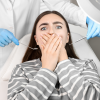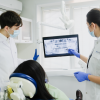
Glossary of dental terms
You’ve probably heard all kinds of strange terms when you’ve visited the dentist. We don’t believe you should be confused about anything you hear in our offices, so here’s a handy guide to some of the unique terminology related to dental care.
Abutment
The teeth on either side of any missing tooth. Abutments are the part of the bridge used to support the replacement of the missing teeth.
Amalgam
Silver filling. Amalgams are usually placed on the back (or posterior) teeth because they are stronger than composite fillings and those teeth do the most chewing.
Anethesia
Relieves the sensation of pain. There are different kinds of anesthesia.
Anterior Teeth
The front teeth (incisors and cupids).
Arch
The upper or lower jaw.
Back Teeth
See Posterior Teeth
Bicuspids
The first and second bicuspids are the fourth and fifth teeth from the center of the mouth to the back of the mouth. These are the back teeth that are used for chewing, they only have two points (cusps).
Bitewing
X-ray that shows the upper and lower teeth’s biting surfaces on the same film. This x-ray shows the portion of the teeth above the gumline.
Bridge
A fixed appliance (prosthesis) that replaces missing teeth. A bridge is a series of crowns (abutments and pontics).
Bruxism
Clenching or grinding of the teeth.
Calculus
The sticky film on your teeth (plaque) that has hardened. Also known as tartar.
Canal
The narrow chamber inside the root of the tooth that contains the nerve and blood vessels.
Caries
Correct technical term for decay.
Complete Series
Full Mouth X-rays.
Composite Fillings
Tooth coloured filling. Insurance companies usually only allow them on the front teeth (anterior teeth). When composites are done on the back teeth (posterior teeth) the insurance company usually pays them as an amalgam. Composites are also known as resin fillings.
Crown
Full coverage for a tooth.
Curettage
Surgical scraping of bacteria from the soft tissue. This is a periodontal procedure and is usually performed one quadrant at a time.
Cusps
The high points on the chewing surfaces of the back teeth (posterior teeth).
Cuspids
The third tooth from the center of the mouth to the back of the mouth. These are the front teeth that have one rounded or pointed edge used for biting. Also known as canines.
Deciduous Teeth
Primary Teeth.
Denture
A removable appliance (prosthesis) that replaces all of the teeth in either the upper or lower jaw.
Diagnostic
Procedures performed by the dentist to identify what’s going on in the mouth. The most common procedures you will deal with are the exam and x-ray which Trojan classifies as preventive.
Edentulous
All the teeth are missing in either the upper or lower arch.
Endodontics (Endo)
The treatment of diseases or injuries that affect the root tip or nerve of the tooth. The most common procedure that you will deal with is a root canal.
Flouride
Topical application of a gel or liquid that prevents decay.
Full Mouth X-Rays (FMX)
X-rays showing all the teeth. Includes 14 periapicals and 2 or 4 bitewings. Also known as a complete series.
General Anesthesia
Relieves the sensation of pain on the whole body. General anesthesia renders you unconscious.
Gingiva
The gums.
Impaction
An unerupted or partially erupted tooth that will not fully erupt because it is obstructed by another tooth, bone, or soft tissue.
Implant
A post that is implanted in the bone. A crown, bridge or denture is then placed over the implant
Incisors
The central and lateral incisor, those are the first and second teeth from the center of the mouth to the back of the mouth. These are the front teeth with the flat edges for biting.
Inlay
A laboratory processed restoration made of metal, acrylic or porcelain. This filling does not involve the high points of the tooth (cusps).
Local Anesthesia
Relieves the sensation of pain in a localized area.
Mandible
The lower jaw.
Maxilla
The upper jaw.
Molars
The first, second and third molars, those are the sixth, seventh and eighth teeth from the center of the mouth to the back of the mouth. The back teeth with the large chewing surface on top. They have 4 points (cusps).
Nightguard
A removable acrylic appliance to minimize the effects of grinding the teeth (bruxism) or joint problems (T.M.J.). Usually worn at night to prevent the grinding of teeth or relieve joint pain. Also known as an occlusal guard.
Occlusal
The chewing surfaces of the back teeth.
Occlusal Guard
A removable acrylic appliance to minimize the effects of grinding the teeth (bruxism) or joint problems (T.M.J.). Usually worn at night to prevent the grinding of teeth or relieve joint pain. Also called a Nightguard.
Onlay
A laboratory processed restoration made of metal, porcelain or acrylic that replaces one or more of the highest points of the tooth (cusps).
Oral Surgery (OS)
Surgery of the mouth.
Orthodontics (Ortho)
Straightening of the teeth.
P.A.
Common dental language for a periapical. See Periapical.
Palate
Roof of the mouth.
Panorex
An x-ray taken outside of the mouth that shows all the teeth on one film.
Partial Denture
A removable appliance (prosthesis) that replaces some of the teeth in either the upper or lower jaw.
Pedodontics (Pedo)
The treatment of children’s teeth.
Periapical
An x-ray that shows the whole tooth (above and below the gumline). Also known as a single film or P.A.
Perio Charting
Measures the depth that the gums have detached from the side of the tooth forming a pocket (perio pocket).
Periodontal Maintenance
Cleaning of the teeth following periodontal treatment, includes perio charting. Procedure code 4910. Also known as a perio prophy or perio recall.
Periodontics (Perio)
The treatment of diseases of the gum or bone (supporting structure).
Perio Pocket
The pocket that forms when the gums detach from the side of the tooth.
Perio Prophy
Periodontal Maintenance.
Perio Recall
Periodontal Maintenance.
Permanent First and Second Molars
The adult first and second molars, they are the sixth and seventh teeth from the center of the mouth to the back of the mouth. Does not include the third molar (wisdom tooth).
Permanent Molars
The adult first, second and third molars.
Permanent Teeth
The adult teeth. Also known as the permanent dentition.
Plaque
A sticky film on the teeth. If it is not removed by brushing it can harden into calculus.
Pontic
The part of a bridge that replaces the missing teeth.
Posterior Teeth
The back teeth (Bicuspids and molars).
Preventive
Procedure performed to prevent decay and gum disease. The procedures that Trojan classifies as preventive are the exam, x-rays and prophys. The exam and x-rays are also known as diagnostic procedures.
Primary Teeth
The baby teeth. Also known as the primary dentition. The baby teeth are replaced by the adult teeth (permanent teeth).
Prophylaxis (Prophy)
Cleaning the teeth. Also known as a prophy.
Prosthetics
A fixed or removable appliance to replace missing teeth. Example: bridges, dentures and partials. Sometimes single crowns are considered prosthetics.
Prosthodontics
Dealing with the replacement of missing teeth.
Quadrant
One of the four equal sections of the mouth. The upper right, upper left, lower right or the lower left.
Root Canal Therapy (RCT)
The nerve of the tooth is removed from the canal inside the root and replaced with a filling material
Root Planing
Deep cleaning of the teeth to remove calculus below the gumline. This is not a prophylaxis. This is a periodontal procedure and is usually performed one quadrant at a time.
Sealant
Clear application of acrylic placed over the biting surface of the tooth to prevent decay.
Tartar
See Calculus.
Temporomandibular Joint (TMJ)
Temporo (temporal bone), mandibular (lower jaw). This is the connecting hinge between the lower jaw and base of the skull. Also known as
Third Molar
Wisdom Tooth.
Virgin Teeth
Teeth that have no decay or fillings.
Wisdom Tooth
The third molar, the eighth tooth from the center of mouth to the back of the mouth. Wisdom teeth are often impacted (obstructed from erupting) and have to be extracted.



